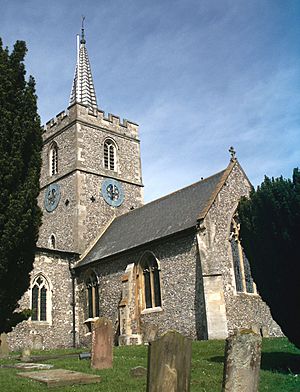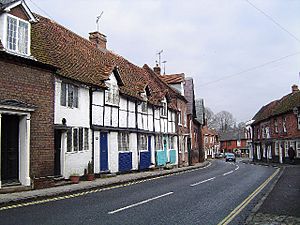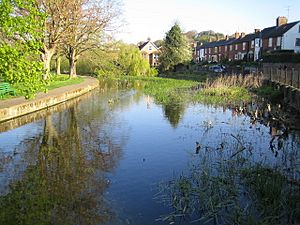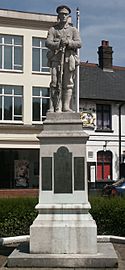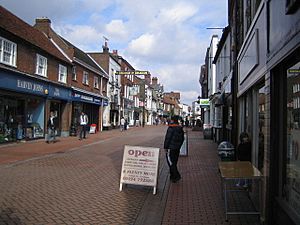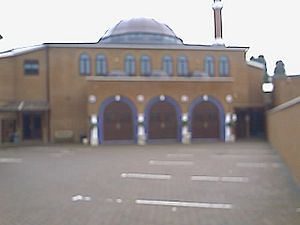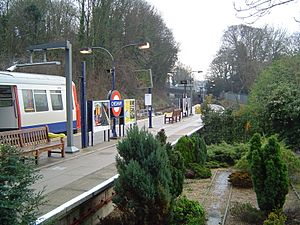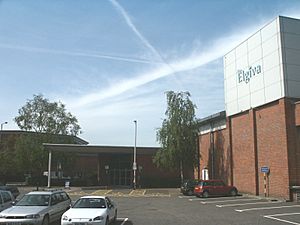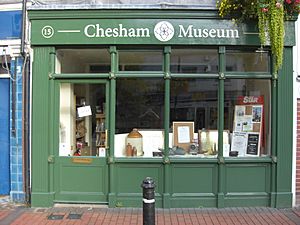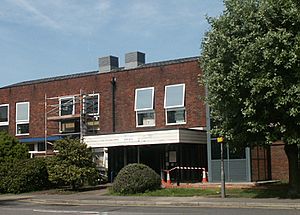Chesham facts for kids
Quick facts for kids Chesham |
|
|---|---|
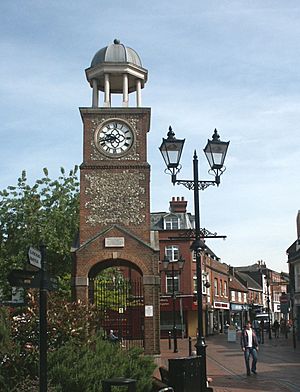 The Chesham clock tower, located in the Market Square |
|
| Population | 23,088 (2021) |
| OS grid reference | SP965015 |
| • London | 25.8 miles (41.5 km) SE |
| Civil parish |
|
| Unitary authority |
|
| Ceremonial county | |
| Region | |
| Country | England |
| Sovereign state | United Kingdom |
| Post town | CHESHAM |
| Postcode district | HP5 |
| Dialling code | 01494 |
| Police | Thames Valley |
| Fire | Buckinghamshire |
| Ambulance | South Central |
| EU Parliament | South East England |
| UK Parliament |
|
Chesham (pronounced CHESH-əm) is a lively market town in Buckinghamshire, England. It's about 11 miles (18 km) southeast of Aylesbury and 26 miles (42 km) northwest of central London. Many people who live here travel to London for work, making it part of the "London commuter belt." The town sits in the beautiful Chess Valley, surrounded by green farmland.
People have lived in the Chesham area for a very long time, with signs of settlement from around 8000 BC. The first official records of Chesham as a town date back to the late 900s. In 1257, King Henry III gave Chesham a special permission, called a royal charter, to hold a weekly market. This helped the town grow and become an important trading spot.
Chesham is famous for its four Bs: boots, beer, brushes, and Baptists. These were the main industries and a strong religious group that shaped the town's history. While these traditional industries faced tough competition and declined in the late 1800s and early 1900s, new businesses moved in. Today, Chesham has many small companies involved in light industry, technology, and professional services.
Since the early 1900s, Chesham has grown a lot, with new homes and public buildings. It has become a popular place for commuters, with better connections to London through the London Underground and road networks. The town centre has been updated since the 1960s and became a pedestrian-only area in the 1990s, making it nicer for shoppers. In 2021, the town's population was 23,008.
Contents
- A Look Back: Chesham's History
- Chesham's Location and Landscape
- Important Places to See
- Chesham's Economy
- How Chesham is Governed
- Public Services
- Religion in Chesham
- People of Chesham
- Getting Around Chesham
- Learning in Chesham
- Fun and Culture
- Media and Filming
- Famous People from Chesham
- Freedom of the Town
- See also
A Look Back: Chesham's History
Evidence shows that people lived in Chesham as early as 5000 BC, during the Stone Age. They left behind many flint tools. Later, around 2500 BC, the first farmers arrived. Bronze Age tribes settled here around 1800 BC, followed by Iron Age people around 500 BC. Between 150 and 400 AD, there was Romano-British farming, and a Roman villa was found nearby at Latimer. After that, the area was empty until the Saxon period in the 600s.
The town's name, Chesham, comes from an old English name, Cæstæleshamm. This means "the river-meadow at the pile of stones." This name was first recorded around 970 in the will of Lady Ælfgifu, a queen who owned land here. She gave her estate to a monastery called Abingdon Abbey.
Before the Norman Conquest in 1066, Chesham had three main estates. The Domesday Book, a famous survey from 1086, mentions these estates and four mills. After 1066, William the Conqueror divided the royal lands among his family and supporters.
Who Owned the Land?
The Domesday Book shows that four different people owned land in Chesham after the Norman Conquest. The biggest share went to Hugh de Bolebec. Over time, the three main Chesham estates became known as Chesham Higham, Chesham Bury, and Chesham Bois.
In the 15th century, the Seymour family owned much of Chesham, then sold it to the Cavendish family. The Cavendishes, who were Dukes of Devonshire, had a big influence on the town until the 1800s. The Lowndes family began buying land in the 1500s. William Lowndes, an important politician, rebuilt the main manor house, The Bury, in 1712. The Lowndes family became very important locally, helping the town grow and improve.
Churches and Faith in Chesham
There's no proof of a church in Chesham before the Norman Conquest. However, stones found under the current church suggest a wooden church might have been there during the Anglo-Saxon period. The church we see today, St Mary's Church, was dedicated to St Mary around 1154. Over the centuries, different monasteries and powerful families owned parts of the church's rights.
In 1536, King Henry VIII took control of church property during the Dissolution of the Monasteries. Later, the Dukes of Bedford gained control of the church's rights. While there were once two vicars (priests) for St Mary's, a single one was appointed from the 1600s. As Chesham grew, a new church, Christ Church, was built in 1867, and more churches followed in nearby areas.
Religious Dissenters
Chesham is well-known for its history of religious dissent, meaning people who disagreed with the main church. In 1532, Thomas Harding was burned at the stake in Chesham for being a Lollard, a follower of John Wycliffe who believed people should read the Bible in English.
From the 1600s, Chesham became a hub for non-mainstream religious groups. Quakers met here in the late 1600s and built their meeting house in 1798. The first Baptists met around 1640, and their first chapel opened in 1712. John Wesley, the founder of Methodism, preached in Chesham in the 1760s. Many different Baptist and Methodist chapels were built in the 18th and 19th centuries.
Moving to America
In 1630, Aquila Chase left Chesham to join a new colony in America. His descendants became important figures in American politics and business. For example, Salmon P. Chase was a US Treasury Secretary and Chief Justice in the 1870s. The famous Chase Manhattan Bank is named after him.
Chesham's Industries
In medieval times, Chesham's main industries were making flour, working with wood, and weaving wool. Four mills along the River Chess used water power to grind flour, and extra flour was sent to London. The number of cloth workers grew quickly between 1530 and 1730, making it the town's biggest industry before it declined. In the late 1700s, mills were changed to make paper, but this didn't last, and they went back to making flour in the 1850s.
New industries appeared from the 1500s. The local woodlands provided wood for London. A small industry making wooden items like shovels, brooms, and chairs started around 1538. Straw plaiting, where women and girls braided straw for hats, was a common home-based job from the 1700s until about 1860. Lace making also grew in the 1500s, with Chesham specializing in black lace. This industry declined in the 1850s due to machines.
One unique company was George Tutill, which made high-quality banners, especially for trade unions. This company still exists today, making flags and banners.
The "four Bs" of Chesham's industries were brush making, boot and shoe making, and beer brewing. Brush making started around 1829, using wood scraps. Boot and shoe making grew after tanneries opened around 1792, providing leather. By the mid-1800s, both were major factory industries. Beer brewing also grew quickly in the 1800s. All three declined in the early 1900s.
Newer businesses took their place. In 1908, the Chiltern Toy Works opened, making high-quality teddy bears until 1960. After the Second World War, industries included making glue, aluminum packaging, balloons, and household cleaning products.
Chesham in Times of War
King Henry VIII taxed Chesham to pay for his wars. Later, in the 1600s, Chesham people strongly opposed King Charles I's "Ship Money" tax. During the English Civil War, most people in Chesham supported the Parliamentarians (Roundheads). Important Parliamentarian leaders and troops were based in the town in 1642. There were small fights nearby in 1643.
In 1798, over 800 men in Chesham joined a local militia to defend the town from a possible invasion by Napoleon I. During the First World War, 188 servicemen from Chesham died. Alfred Alexander Burt, a corporal from Chesham, received the Victoria Cross for his bravery in 1915. The town also hosted soldiers for training.
In the Second World War, 80 servicemen from Chesham lost their lives. Air raid shelters were built in 1940, and although Chesham wasn't a main target, about 45 bombs fell in the area, killing at least nine people.
Social Life and Changes
A workhouse for poor people operated in Chesham from 1777. In 1835, when control of the workhouse was moved, there were riots because people didn't want the poor moved to a rival town.
Public education began with schools opening in 1825 and 1845. The Chesham Building Society opened in 1845 and operated until 2010. Other public services like a Fire Brigade (1846), a cemetery (1858), and a police station (1861) also started around this time.
Chesham's first hospital opened in 1869. It closed in 2005 and was later damaged by fire. The town got its own waterworks in 1875 and mains drainage in 1887. A gasworks was built in 1847. Bathing in the River Chess was a tradition, and an open-air swimming pool was built in 1912.
Transport connections came late to Chesham. The Metropolitan Railway (now part of the London Underground) reached Chesham in 1889. The town expanded a lot between the two world wars and in the 1950s and 60s, with new public housing.
The first cinema showings in Chesham were around 1900. The first purpose-built cinema opened in 1912. Over the years, cinemas changed and closed due to competition from television. Today, The Elgiva Theatre, built in 1976 and rebuilt in 1998, shows films and live performances.
Chesham's Location and Landscape
Chesham is located in the Chiltern Hills, about 13 miles (21 km) southeast of Aylesbury and 25 miles (40 km) northwest of central London. It's the fourth largest town in Buckinghamshire.
Hills, Valleys, and Rivers
Chesham sits in the Chiltern Hills. The town's lowest point is 295 feet (90 meters) above sea level, and it rises up the valley sides. It's at the meeting point of four dry valleys, which were formed by meltwater at the end of the last ice age. The town is built on chalk, gravel, and silt.
The River Chess is a special type of river called a chalk-stream. It starts from three springs near the town. The river was once known as the Isen. Today, parts of the river flow underground through pipes before coming out at Waterside and continuing southeast towards Latimer and then joining the River Colne.
Town Development and People
Chesham grew as a market town, helped by its factories and mills along the River Chess. Until the 1800s, the town centre was in the southeast. Most of the current town centre was built during Victorian times. The "old town," especially Church and Germain Street, is well-preserved and has many historic buildings. St Mary's Church, built in the 12th century, was updated in the 1800s. The Bury, a grand house, was built in 1712.
The town's population grew from 2,425 in 1841 to over 9,000 by the late 1800s. This caused the town centre to shift east. After the Second World War, the town centre was redeveloped. In the 1960s, St Mary's Way was built to redirect traffic around the busy High Street, which was later made pedestrian-only in the 1990s. Industrial areas are now mainly in Waterside and Asheridge Vale.
Compared to other towns in south Buckinghamshire, Chesham has more social rental homes and fewer detached, owner-occupied houses. Housing expanded mainly east of the old town, especially after the railway arrived in the 1880s. The population grew quickly after World War II as people moved from London for work. Today, many people who live in Chesham work outside the town, commuting by car or train.
Weather in Chesham
Chesham has a typical British climate, with mild temperatures. However, the lower parts of the valley can get much colder on clear, calm nights. The lowest temperature ever recorded in Chesham was -19.6°C (-3.3°F) in December 2010.
| Climate data for Chesham | |||||||||||||
|---|---|---|---|---|---|---|---|---|---|---|---|---|---|
| Month | Jan | Feb | Mar | Apr | May | Jun | Jul | Aug | Sep | Oct | Nov | Dec | Year |
| Mean daily maximum °C (°F) | 8 (46) |
9 (48) |
12 (54) |
14 (57) |
18 (64) |
21 (70) |
23 (73) |
23 (73) |
20 (68) |
16 (61) |
11 (52) |
8 (46) |
15 (59) |
| Mean daily minimum °C (°F) | 2 (36) |
3 (37) |
4 (39) |
5 (41) |
8 (46) |
11 (52) |
13 (55) |
13 (55) |
10 (50) |
7 (45) |
4 (39) |
3 (37) |
7 (44) |
| Average precipitation mm (inches) | 50.8 (2.00) |
44.4 (1.75) |
42.9 (1.69) |
51.1 (2.01) |
51.7 (2.04) |
46.1 (1.81) |
43.9 (1.73) |
74.9 (2.95) |
50.1 (1.97) |
66.8 (2.63) |
61.8 (2.43) |
57.5 (2.26) |
642 (25.27) |
| Source: World Weather Online | |||||||||||||
Areas and Neighborhoods
Chesham is made up of several smaller communities:
- Asheridge Vale: A housing area and industrial estate on the northwest side.
- Botley: A small village east of Chesham.
- Chesham Vale: An area on the northern edge of town.
- Chessmount: An area east of the town centre.
- Codmore: An old village northeast of the town centre.
- Great Hivings: An area north of Chesham.
- Hilltop: A residential area on a steep hill northeast of town.
- Lye Green: A village northeast of the main town.
- Lowndes: A residential area near Lowndes Park and Chiltern Hills Academy.
- Newtown: A housing area built in the late Victorian era, now part of the town.
- Old Town: The original town centre, now a historic conservation area with St Mary's Church.
- Pednormead End: An area west of the main town.
- Pond Park: A housing area built after World War II, north of town.
- Townsend: A Victorian extension to the town with shops, homes, and Chesham Grammar School.
- Waterside: Once a village south of the town centre, with mills and factories. It has a large open space called the Moor.
Important Places to See
Clock Tower
A clock tower built in 1992 stands in Market Square. It's on the spot where Chesham's old town hall used to be. The top part of the tower is a copy of the original one from the 1800s, and it even uses the original clock face and mechanism.
War Memorial
The Chesham war memorial is in a garden in the Broadway. It shows a soldier and honors those who died in the First World War and Second World War. It was designed by sculptor Arthur George Walker and unveiled in 1921.
Chesham's Economy
Farming and Mills
Before the Normans arrived, Chesham had farms that grew enough food to support four water-powered mills on the River Chess. These mills produced extra flour that was sent to London. There was also plenty of woodland for pigs and timber. Sheep on the hills provided wool for cloth making.
Old Industries
Until the 1700s, Chesham's economy hadn't changed much since its market charter in 1257. The planting of beechwoods helped Chesham become a centre for making wooden furniture parts and other items. Mills along the Chess made paper and silk until the mid-1800s. Home-based workers made lace and braided straw, but these jobs declined due to new machines and cheaper imports. The clean water of the Chess was perfect for growing watercress, which was a big industry in the Victorian era until after World War II.
Factories and Breweries
In the 1700s, leather workers moved from home workshops to factories like Barnes Boot factory. By the late 1800s, there were many boot and shoe factories. Brush making started in 1829, using local beech wood. At its peak, Chesham had about 12 brush factories. Today, only one remains.
Several breweries opened in Chesham in the 1800s, like Nash's Chesham Brewery. They faced competition and eventually merged, but brewing continued until the 1950s.
Businesses Today
Today, Chesham has many small and medium-sized businesses. The two industrial parks have light engineering, printing, design, and technology companies. There are also many professional services. The pedestrian-only High Street still feels like an old market town, with some long-standing family shops. It also has a street market on Wednesdays and Saturdays. Chesham's High Street is known for being unique. There are also large supermarkets, which compete with the local independent shops.
How Chesham is Governed
Parliamentary Representation
Chesham is part of the Chesham & Amersham parliamentary area. This area used to always elect a Conservative Member of Parliament. However, in a special election in 2021, Sarah Green from the Liberal Democrats was elected.
Town's Coat of Arms
Chesham has its own coat of arms, granted in 1961. The colors are the same as Buckinghamshire's. Two beech trees represent the Chiltern woodlands. The black and white squares and rooks represent the River Chess. The swan comes from the Dukes of Buckingham. The lilies are for St Mary, the town's patron saint. The buck's head is from the Cavendish family, who owned much of the land. The town's motto is from the Bible.
Public Services
Emergency Services
Thames Valley Police handles policing in Chesham. Buckinghamshire Fire and Rescue Service manages fire and rescue, with a fire station in Bellingdon Road. South Central Ambulance Service provides ambulance services, with the nearest station in Amersham.
Utilities
Veolia Water Central supplies drinking water to Chesham. Thames Water handles waste water treatment. Chiltern District Council is in charge of waste management. EDF Energy provides electricity.
Religion in Chesham
St Mary's Church is the oldest church building in Chesham, dating back to at least the 12th century. Chesham has a long history of religious dissent, with people like the Lollards who were persecuted for their beliefs. Thomas Harding, a Lollard from Chesham, was executed in 1532 for fighting for the right to read the Bible in English.
The 17th, 18th, and 19th centuries saw a rapid growth of non-conformist groups, especially Baptists. Today, Chesham has several Baptist and Anglican churches, a United Reformed Church, a Roman Catholic church, a Methodist chapel, and a historic Quaker Friends Meeting House. Most Christian churches in Chesham work together as part of "Churches Together for Chesham." Other religious groups include the Chesham Spiritualist Church and Jehovah's Witnesses.
During the Second World War, Jewish families who moved to Chesham from London formed the first recorded Jewish community. Later, a Liberal Jewish community was formed in 1990.
In the second half of the 20th century, a large Muslim community grew in Chesham. Chesham Mosque, the first purpose-built mosque in the town, was finished in 2005.
People of Chesham
Here's a look at the people who live in Chesham, based on the 2011 census:
- Population: 21,483 (10,600 males, 10,883 females).
- Marital Status: 51.2% married, 34.5% single.
- Housing: 67.6% own their homes, 20.6% rent from the public sector, 10.1% rent privately.
- Car Ownership: 83% of households own a car.
- Work/Study: 54% employed, 13.2% self-employed, 2.4% studying.
- Not Working: 12.9% retired, 5.9% unemployed.
- Travel to Work: 66% use a car, 11.5% use a train, 10% walk.
Getting Around Chesham
Train and Tube
Chesham tube station is the end of the Chesham branch, a single-track line off the London Underground Metropolitan line. The station opened in 1889. In 1959, the line was electrified, making connections to London more reliable. Chesham is the furthest point from central London on the Underground network. Since 2010, Chesham has had direct trains to London all day.
The nearest main train connections are at Amersham, where you can connect to Chiltern Railways for trains to Marylebone.
Roads
Historically, Chesham didn't have good road links. Major stagecoaches bypassed the town. However, after the Second World War, things improved with the opening of the M1 motorway. The A416 now runs through the town. In 1990, Chesham's High Street became pedestrian-only, which has been good for the shopping area.
Buses
Local bus companies like Carousel Buses and Red Rose run services connecting residential areas to the town centre. Buses also connect Chesham to nearby towns like Amersham, High Wycombe, and Hemel Hempstead.
Cycling
There aren't many dedicated cycle paths in Chesham. However, the town is a good starting point for exploring the Chilterns, and there are cycling trails in the countryside around Chesham.
Airports
Luton airport is 15 miles (24 km) away, and Heathrow airport is 22 miles (35 km) away.
Learning in Chesham
Primary Schools
Since 1996, primary education in Chesham has been for ages 4 to 11. There are six primary schools in Chesham: Elmtree First School, Newtown Infant School, Brushwood Junior School, Thomas Harding Junior School, Ivingswood Academy, and Waterside Combined School.
Secondary Schools
Buckinghamshire has a selective education system. Students take an eleven plus exam to decide if they go to a Grammar school or a Secondary Modern School (also called an Upper School). Chesham has two secondary schools: Chiltern Hills Academy, a Church of England school, and Chesham Grammar School. Chesham is also close to Dr Challoner's Grammar School for boys and Dr Challoner's High School for girls.
There are also independent fee-paying schools in the area, including Chesham Preparatory School.
Special and Adult Education
Chesham is home to Heritage House School, a nationally recognized Special school for students aged 2 to 19 with severe learning difficulties. Amersham & Wycombe College has a campus in Chesham, offering full-time and part-time courses. Adult learning courses are also available at several locations in the town.
Fun and Culture
Community Places
The Elgiva Theatre, owned by Chesham Town Council, is a theatre and cinema with 300 seats. It hosts plays, musicals, comedy shows, concerts, films, and exhibitions. The Little Theatre by the Park is used by local theatre groups and for dance classes.
Chesham Museum opened in 2004 and is located in Market Square. It tells the story of the town and its surrounding area. Chesham also has an annual Schools of Chesham carnival, a Beer festival, and a festival every two years.
Chesham Library opened in 1923. It has moved locations over the years and now offers modern facilities, including a study centre. It also has a special collection of Victorian children's books, some once owned by Florence Nightingale.
The White Hill Centre, an old school site, offers educational, recreational, and social activities for the community.
Lowndes Park is a large park with playgrounds and a pond called Skottowe's Pond. The Lowndes family donated it to the town in 1953. The Moor, an open space by the River Chess, is used for recreation and traveling fairs. Chesham has two public swimming pools: an outdoor pool at the Moor and a covered pool at the top of White Hill. The town is also known as a "Walkers are Welcome Town" because of its many footpaths.
Sports
Chesham United F.C. is the local football club. They play in the Southern League Premier Division. The club was formed in 1917. Their most successful period was in 1967–68 when they reached the FA Amateur Cup final at Wembley Stadium.
Chesham cricket club was founded in 1848 and plays at Amy Lane. It has several senior teams and a junior section. Chesham Rugby union Club, known as 'The Stags', started in 1980 and has teams for boys, girls, and adults.
Town Twinning
Chesham has twinned with three towns in other countries to promote cultural exchange:
- Friedrichsdorf, Germany (since 1980)
- Houilles, France (since 1986)
- Archena, Spain (since 1995)
Media and Filming
Local News
The local newspaper covering Chesham is the Buckinghamshire Examiner, founded in 1889. Another newspaper that covers the area is the Bucks Free Press.
Local Radio
Radio stations for Chesham include BBC Three Counties Radio and Heart London. Chiltern Voice is a local community radio station that broadcasts on 107.4fm.
TV and Phone Signals
Because Chesham is in a valley, TV and radio reception can sometimes be poor. The town has its own TV mast. Mobile phone reception can also be weak in some parts of Chesham and nearby villages.
Filming Locations
Chesham's Old Town and pedestrianised High Street have been used as filming locations for several TV series and films:
- The Professionals (1978)
- Hammer House of Horror (1980)
- Inspector Morse (1993)
- Midsomer Murders (several episodes from 1997 to 2010)
- Nuzzle and Scratch (2009)
- Scoop (2009)
- Chucklevision (2000)
- Black Mirror: "The National Anthem" (2011)
- The Imitation Game (2014)
- Doctor Foster (2015)
Famous People from Chesham
- Aneurin "Nye" Bevan (1897–1960): A Labour politician who helped create the National Health Service. He lived near Chesham.
- Val Biro (1921–2014): Children's author of the Gumdrop books, lived in Chesham.
- Alfred Alexander Burt (1895–1962): A soldier from Chesham who received the Victoria Cross for bravery in World War I.
- Alice Connor (born 1980): Actress, attended school in Chesham.
- Roger Crab (1606–1680): An eccentric person who lived in Chesham. Some believe he inspired the "Mad Hatter" character in Alice in Wonderland.
- Andrew Davis (born 1944): A British conductor who grew up in Chesham.
- Stephen Fry (born 1957): Famous actor and comedian, spent part of his childhood in Chesham.
- Thomas Harding (died 1532): A religious dissenter from Chesham who was executed for his beliefs.
- Alex Horne (born 1978): Stand-up comedian, lives in Chesham.
- Eddie Howe (born 1977): Football manager, grew up in Chesham.
- Arthur Lasenby Liberty (1843–1917): Founder of the famous Liberty store in London, lived in Chesham.
- William Lowndes (1652–1724): An important British politician who built and lived at Bury House in Chesham.
- Margaret Mee (1909–1988): Born in Chesham, she became a famous botanical artist known for her paintings of plants from the Amazon rainforest.
- Guy Siner (born 1947): Actor, known for 'Allo 'Allo!, lives in Chesham.
- Francis Wilson (born 1949): TV weatherman, used to live in Chesham.
Freedom of the Town
The "Freedom of the Town" is a special honor given to people who have done great things for Chesham. Here are some who have received it:
- Vincent Crompton: 14 May 2015
- Katherine Merchant: 9 May 2019
- Rocky Clarke: 9 May 2019
- Mora Walker: 9 May 2019
- Rod Culverhouse: 9 May 2019
- Philip Folly
- Helen Salisbury: 27 September 2021
See also
 In Spanish: Chesham para niños
In Spanish: Chesham para niños



